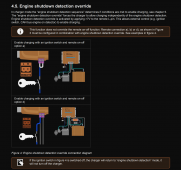mikeboatboy
New Member
- Joined
- Jul 23, 2022
- Messages
- 27
I've upgraded the house bank on my boat to Lithium, 35 amp alternator charges the AGM start bank, which then charges the Lithium via a Victron 12/12/18 DC/DC charger. All good there.
Question is, my shore-power battery charger is designed for lead acid/agm and connected to the AGM start bank, and it's a 5-amp charger. Once the AGM is charged, will it be OK to use the DC/DC charger to use the "overflow" energy to pass along to the Lithium battery? Or should I buy another shore-power charger specifically for Lithium,
Or am I misunderstanding something. My hope is once the AGM is charged sufficiently, the DC/DC charger will start requesting power to charge the Lithium and that power will be provided.
With the 5-amp shore-power charger, and the 18-amp DC/DC charger, I can see the Lithium depleting the AGM fairly fast because the 5-amp shore-power charger won't be able to keep up. The DC/DC charger will shut down, let the AGM top up again, then turn on again, over and over until the Lithium is fully charged.
Trying to keep things simple and not have to buy more stuff if I don't have to. Another idea I had was to buy a 30-amp shore-power charger that would be able to keep up with the DC/DC 18 amp charger.
Any ideas? Or should I just have two shore-power chargers, one for each bank.
Question is, my shore-power battery charger is designed for lead acid/agm and connected to the AGM start bank, and it's a 5-amp charger. Once the AGM is charged, will it be OK to use the DC/DC charger to use the "overflow" energy to pass along to the Lithium battery? Or should I buy another shore-power charger specifically for Lithium,
Or am I misunderstanding something. My hope is once the AGM is charged sufficiently, the DC/DC charger will start requesting power to charge the Lithium and that power will be provided.
With the 5-amp shore-power charger, and the 18-amp DC/DC charger, I can see the Lithium depleting the AGM fairly fast because the 5-amp shore-power charger won't be able to keep up. The DC/DC charger will shut down, let the AGM top up again, then turn on again, over and over until the Lithium is fully charged.
Trying to keep things simple and not have to buy more stuff if I don't have to. Another idea I had was to buy a 30-amp shore-power charger that would be able to keep up with the DC/DC 18 amp charger.
Any ideas? Or should I just have two shore-power chargers, one for each bank.





